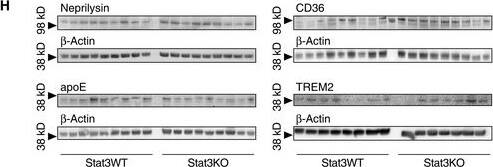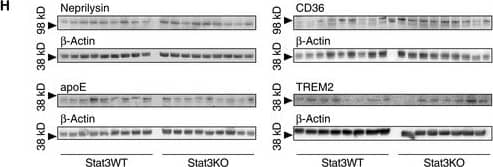Mouse Neprilysin/CD10 Antibody
R&D Systems, part of Bio-Techne | Catalog # AF1126


Key Product Details
Species Reactivity
Validated:
Cited:
Applications
Validated:
Cited:
Label
Antibody Source
Product Specifications
Immunogen
Tyr52-Trp750
Accession # AAA37386
Specificity
Clonality
Host
Isotype
Scientific Data Images for Mouse Neprilysin/CD10 Antibody
Neprilysin/CD10 in Mouse Brain.
Neprilysin/CD10 was detected in perfusion fixed frozen sections of mouse brain (glial cell in hippocampus) using 15 µg/mL Goat Anti-Mouse Neprilysin/CD10 Antigen Affinity-purified Polyclonal Antibody (Catalog # AF1126) overnight at 4 °C. Tissue was stained (red) and counterstained (green). View our protocol for Fluorescent IHC Staining of Frozen Tissue Sections.Detection of Mouse Neprilysin/CD10 by Western Blot
Astrocyte‐specific Stat3 deletion increases microglial A beta internalization and degradation, and reduces apoE expression, dystrophic neurites, and detrimental cytokinesAInternalization of A beta (stained with IC16 antibody or methoxy‐XO4) was assessed using an engulfment assay, in which glial and A beta structures were surface‐rendered and A beta volumes co‐localized with glial volumes were quantified. Scale bars, 10 μm.B, CMicroglia (left Y axes) from APP/PS1 mice internalized significantly more A beta positive for IC16 or methoxy‐XO4 when Stat3 was deleted in astrocytes (*P < 0.05, Mann–Whitney test), whereas no changes were seen in astrocytes (right axes; APP/PS1‐Stat3WT, n = 8 (four females and four males) mice; APP/PS1‐Stat3KO, n = 11 (five females and six males) mice; age, 11 months; Mann–Whitney test).D–H(D–F) Western blot quantification of protein levels of the A beta‐degrading enzymes neprilysin/CD10 and CD36, as well as the A beta‐binding apolipoprotein E (apoE), revealed a significantly increased expression of neprilysin and CD36 and a decreased expression of apoE (APP/PS1‐Stat3WT, n = 9 (five females and four males) mice; APP/PS1‐Stat3KO, n = 9 (five females and four males) mice; age, 11 months; *P < 0.05, Mann–Whitney test for all comparisons). (G) In contrast, TREM2 expression remained unchanged (APP/PS1‐Stat3WT, n = 8 (four females and four males) mice; APP/PS1‐Stat3KO, n = 7 (four females and three males) mice; age, 11 months; Mann–Whitney test). (H) Western blots for proteins analyzed in (D‐G).Data information: Data are represented as mean ± SEM.Source data are available online for this figure. Image collected and cropped by CiteAb from the following open publication (https://pubmed.ncbi.nlm.nih.gov/30617153), licensed under a CC-BY license. Not internally tested by R&D Systems.Detection of Mouse Neprilysin/CD10 by Western Blot
Astrocyte‐specific Stat3 deletion increases microglial A beta internalization and degradation, and reduces apoE expression, dystrophic neurites, and detrimental cytokinesAInternalization of A beta (stained with IC16 antibody or methoxy‐XO4) was assessed using an engulfment assay, in which glial and A beta structures were surface‐rendered and A beta volumes co‐localized with glial volumes were quantified. Scale bars, 10 μm.B, CMicroglia (left Y axes) from APP/PS1 mice internalized significantly more A beta positive for IC16 or methoxy‐XO4 when Stat3 was deleted in astrocytes (*P < 0.05, Mann–Whitney test), whereas no changes were seen in astrocytes (right axes; APP/PS1‐Stat3WT, n = 8 (four females and four males) mice; APP/PS1‐Stat3KO, n = 11 (five females and six males) mice; age, 11 months; Mann–Whitney test).D–H(D–F) Western blot quantification of protein levels of the A beta‐degrading enzymes neprilysin/CD10 and CD36, as well as the A beta‐binding apolipoprotein E (apoE), revealed a significantly increased expression of neprilysin and CD36 and a decreased expression of apoE (APP/PS1‐Stat3WT, n = 9 (five females and four males) mice; APP/PS1‐Stat3KO, n = 9 (five females and four males) mice; age, 11 months; *P < 0.05, Mann–Whitney test for all comparisons). (G) In contrast, TREM2 expression remained unchanged (APP/PS1‐Stat3WT, n = 8 (four females and four males) mice; APP/PS1‐Stat3KO, n = 7 (four females and three males) mice; age, 11 months; Mann–Whitney test). (H) Western blots for proteins analyzed in (D‐G).Data information: Data are represented as mean ± SEM.Source data are available online for this figure. Image collected and cropped by CiteAb from the following open publication (https://pubmed.ncbi.nlm.nih.gov/30617153), licensed under a CC-BY license. Not internally tested by R&D Systems.Applications for Mouse Neprilysin/CD10 Antibody
Immunohistochemistry
Sample: Perfusion fixed frozen sections of mouse brain (glial cell in hippocampus)
Immunoprecipitation
Sample: Conditioned cell culture medium spiked with Recombinant Mouse Neprilysin/CD10 (Catalog # 1126-ZN), see our available Western blot detection antibodies
Western Blot
Sample: Recombinant Mouse Neprilysin/CD10 (Catalog # 1126-ZN)
Mouse Neprilysin/CD10 Sandwich Immunoassay
Use in combination with these reagents:
- Detection Reagent: Mouse Neprilysin/CD10 Biotinylated Antibody (Catalog # BAF1126)
- Standard: Recombinant Mouse Neprilysin Protein, CF (Catalog # 1126-ZN)
Reviewed Applications
Read 2 reviews rated 5 using AF1126 in the following applications:
Formulation, Preparation, and Storage
Purification
Reconstitution
Formulation
Shipping
Stability & Storage
- 12 months from date of receipt, -20 to -70 °C as supplied.
- 1 month, 2 to 8 °C under sterile conditions after reconstitution.
- 6 months, -20 to -70 °C under sterile conditions after reconstitution.
Background: Neprilysin/CD10
Neprilysin (NEP, neutral endopeptidase 24.11, EC 3.4.24.11) is a zinc metallopeptidase expressed at the cell surface of a variety of cells. The enzyme functions both as an endopeptidase with a thermolysin-like specificity and as a dipeptidylcarboxypeptidase. NEP has been shown to be involved in the degradation of enkephalins in the mammalian brain and the inactivation of circulating atrial natriuretic peptide (1, 2). NEP has also been identified as the common acute lymphoblastic leukemia antigen (CALLA), and to be expressed on the surface of lymphocytes in some disease states (3). These and other observations have resulted in considerable clinical interest in NEP as a potential target for analgesics and antihypertensive drugs. NEP is also a major degrading enzyme of amyloid beta peptide (A beta) in the brain, indicating that down-regulation of NEP activity, which could be caused by aging, can contribute to the development of Alzheimer’s disease by promoting A beta accumulation (4).
References
- Malfroy, B. et al. (1978) Nature 276:523.
- Kenny, A.J. and S.L. Stephenson (1988) FEBS Lett. 232:1.
- LeTarte, M. et al. (1988) J. Exp. Med. 168:1247.
- Itwata, N. et al. (2001) Science 292:1550.
Alternate Names
Gene Symbol
UniProt
Additional Neprilysin/CD10 Products
Product Documents for Mouse Neprilysin/CD10 Antibody
Product Specific Notices for Mouse Neprilysin/CD10 Antibody
For research use only

